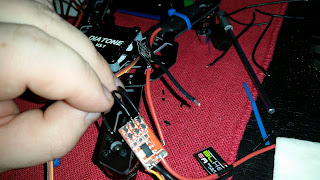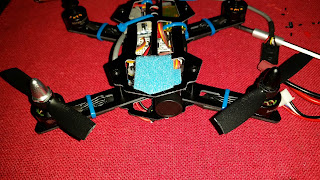TL;DR: You can stretch the cell capacity of your ESCs as long as you understand why the limits are there.
Oh no, I bought the wrong ESC!
Our story today, starts out with a set of 6amp EMAX BLHeli escs. Sometimes I am not smart. Sometimes BangGood is not so kind on how it lists it's items for sale. Pointing fingers is really not useful at this point though.

I bought what I thought were 2-3s EMAX Bl-Heli ESCs. The model I'm building is dependent on 3s. I chose the 6amp ESCs from the menu. There's something special with the 6amp ESCs, they are 1-2s only. That just won't do. BangGoods shipping speed is best compared to the change of seasons. I want to fly my new quad now. So in a panic, I order some new ESCs from hobbyking.
The story could end right there, but this is me we're talking about. Maybe I can make what I have, work.
ESC's are tough little buggers. The inductive spikes from switching on and off many amps are huge. To give you some idea of what this means, this is the exact same technique they use for building switch mode power supplies. This means the drive end of ESCs are built quite durably. Since the output section is so strong, the question is, where do the voltage limits come from?
The first place, are capacitors. As a general rule, you want to run caps that are of at least 50% greater voltage rating than the nominal voltage of your system. 100% greater is even better. These 6amp ESCs have a tiny little surface mount ceramic cap between the positive and negative leads. I suspect that's at least a 30v cap. If you have a bigger ESC, with an electrolytic (eg: Looks like a tiny soda can) cap you can read it's value directly off the shrink wrap on the cap. You don't want to exceed 66% of the voltage of that cap, ideally 50%.
.. If there's enough demand, I'll get pictures of that..
The other thing you'll notice, is that most high voltage ESCs are "Opto" or at least don't have a BEC built in. This is because the BEC is the other limit on ESCs. Typically the BEC is a single chip linear regulator. Linear regulators work by acting as a resistor. Have you ever noticed your ESCs get hot just sitting there, without the model flying? That's the BECs working. If the input voltage is "just a little" more than the supplied voltage, it only dissipates a little heat. AS the input voltage goes up, the more current that BEC needs to burn off. Most BEC equipped ESCs are limited to 3 or 4s for this reason.
Now why is the 6amp ESC limited to 2s? Well, if you want the BEC to function at 1s voltages, you need what's called a LDO regulator. That's Low Drop Out (voltage) regulator. Most linear regs need 1-2 volts of additional voltage over the output voltage to do regulation work. LDO regs can be as little as 0.1 volts.
The big chip you see there, is the LDO regulator. If I were smart, I would have grabbed the part number while I had the ESCs naked.

Why doesn't every ESC use a LDO regulator? The downside is that LDO regs are more delicate. They have lower maximum input voltages, and are much less capable of taking abuse.
My little quadcopter came with a PDB that has a 5v reg on it. By using that PDB, I am able to reduce the load on the ESC's regulators. So the LDO's in the ESCs only need to supply enough charge to keep their micro-controllers running. That's basically leakage voltage.

What's this mean? As long as I'm not using the BEC, it looks like I can use my 6amp 1-2s rated ESCs with 3s. Even if we're operating way outside the specified range of the LDO regulator, the load on it means it should not cook itself.
Tonight I tested the guess. I hooked up a 25c 1000mah 3s pack, and shoved the throttle to max... The motors got warm, but the ESCs didn't. And after 10 minutes, they hadn't cut out. I'm pretty pleased.

The takeaway here isn't to ignore the voltage ratings on your ESCs. But now you know why they say "1-2s" or "2-4s" or "2-6s". It's all about the accessory components of the ESC, not as much the drive side.
I have some spare ESCs hanging around, I'm tempted to see where they start melting down. I've got some 2-3s ESCs that I'd like to run on 4s, so we can extend this experiment beyond the 3s range. There are other limits on ESCs that get much more interesting for the engineering types, but a lot less interesting for people using the ESCs.
And if you'd like to read about the rest of the project, here's my blog post: http://realtinker.blogspot.com/2015/10/building-150-class-quad-diatone-blade.html
Oh no, I bought the wrong ESC!
Our story today, starts out with a set of 6amp EMAX BLHeli escs. Sometimes I am not smart. Sometimes BangGood is not so kind on how it lists it's items for sale. Pointing fingers is really not useful at this point though.

I bought what I thought were 2-3s EMAX Bl-Heli ESCs. The model I'm building is dependent on 3s. I chose the 6amp ESCs from the menu. There's something special with the 6amp ESCs, they are 1-2s only. That just won't do. BangGoods shipping speed is best compared to the change of seasons. I want to fly my new quad now. So in a panic, I order some new ESCs from hobbyking.
The story could end right there, but this is me we're talking about. Maybe I can make what I have, work.
ESC's are tough little buggers. The inductive spikes from switching on and off many amps are huge. To give you some idea of what this means, this is the exact same technique they use for building switch mode power supplies. This means the drive end of ESCs are built quite durably. Since the output section is so strong, the question is, where do the voltage limits come from?
The first place, are capacitors. As a general rule, you want to run caps that are of at least 50% greater voltage rating than the nominal voltage of your system. 100% greater is even better. These 6amp ESCs have a tiny little surface mount ceramic cap between the positive and negative leads. I suspect that's at least a 30v cap. If you have a bigger ESC, with an electrolytic (eg: Looks like a tiny soda can) cap you can read it's value directly off the shrink wrap on the cap. You don't want to exceed 66% of the voltage of that cap, ideally 50%.
.. If there's enough demand, I'll get pictures of that..
The other thing you'll notice, is that most high voltage ESCs are "Opto" or at least don't have a BEC built in. This is because the BEC is the other limit on ESCs. Typically the BEC is a single chip linear regulator. Linear regulators work by acting as a resistor. Have you ever noticed your ESCs get hot just sitting there, without the model flying? That's the BECs working. If the input voltage is "just a little" more than the supplied voltage, it only dissipates a little heat. AS the input voltage goes up, the more current that BEC needs to burn off. Most BEC equipped ESCs are limited to 3 or 4s for this reason.
Now why is the 6amp ESC limited to 2s? Well, if you want the BEC to function at 1s voltages, you need what's called a LDO regulator. That's Low Drop Out (voltage) regulator. Most linear regs need 1-2 volts of additional voltage over the output voltage to do regulation work. LDO regs can be as little as 0.1 volts.
The big chip you see there, is the LDO regulator. If I were smart, I would have grabbed the part number while I had the ESCs naked.

Why doesn't every ESC use a LDO regulator? The downside is that LDO regs are more delicate. They have lower maximum input voltages, and are much less capable of taking abuse.
My little quadcopter came with a PDB that has a 5v reg on it. By using that PDB, I am able to reduce the load on the ESC's regulators. So the LDO's in the ESCs only need to supply enough charge to keep their micro-controllers running. That's basically leakage voltage.

What's this mean? As long as I'm not using the BEC, it looks like I can use my 6amp 1-2s rated ESCs with 3s. Even if we're operating way outside the specified range of the LDO regulator, the load on it means it should not cook itself.
Tonight I tested the guess. I hooked up a 25c 1000mah 3s pack, and shoved the throttle to max... The motors got warm, but the ESCs didn't. And after 10 minutes, they hadn't cut out. I'm pretty pleased.

The takeaway here isn't to ignore the voltage ratings on your ESCs. But now you know why they say "1-2s" or "2-4s" or "2-6s". It's all about the accessory components of the ESC, not as much the drive side.
I have some spare ESCs hanging around, I'm tempted to see where they start melting down. I've got some 2-3s ESCs that I'd like to run on 4s, so we can extend this experiment beyond the 3s range. There are other limits on ESCs that get much more interesting for the engineering types, but a lot less interesting for people using the ESCs.
And if you'd like to read about the rest of the project, here's my blog post: http://realtinker.blogspot.com/2015/10/building-150-class-quad-diatone-blade.html
Last edited:
